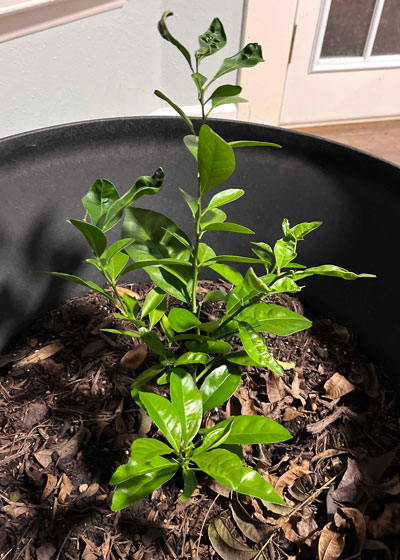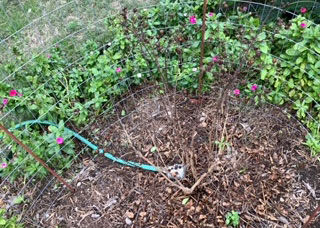Q&A – Ask Neil: December 15, 2022
(Please read these instructions carefully.)
Before you post your question, please look at recent issues to see if someone else has already asked it. You might find your answer there.
November 24, 2022 Q&A part one
November 24, 2022 Q&A part two
How to submit your question…
• Click the link provided below to post your question. After you submit your question, a new window will pop up giving you the address to which you can e-mail a photo to accompany your question. Clear, medium-resolution photos. (Try to avoid low-res thumbnail photos, please, in case I have to zoom in to see things.)
• Click here to post your question.
• Please only post your question one time.
• One question per reader, please.
• Please use this only for posting questions – not for standard emails.
• Watch for your answer in the following week’s e-gardens.
• I choose those of greatest general interest. For example, plant IDs seldom make the cut.
• I must have your first name or initials.
• I must have your city or county. (Texas is a very large state.)
QUESTION 1
WILL PONDEROSA LEMON FROM CUTTING BEAR FRUIT ANY FASTER THAN ITS PARENT?
Question: I have a Ponderosa lemon tree that is about 8 years old. This summer I successfully rooted a cutting from it. Since the parent plant is of fruit-bearing age, will the cutting start making fruit faster, or will I still have to wait years for fruit? Garrett H., San Antonio.

Answer: I decided to go directly to a “smart person” for this answer. Dr. Larry Stein is not only an award-winning horticulturist, he leads the Extension Horticulture program for Texas. I sent him your question and he replied:
“The rooted cutting will begin to make fruit sooner than one grown from a seed. Also, trees grown in containers fruit sooner than those grown in native soil.
“We actually like to grow citrus on their own roots in a homeowner situation as the trees will come back true to type if they do freeze back. In most cases, they grow just as well as those which are grafted.
“Side note: in Uvalde, our own-rooted trees did as well as grafted trees in our satsuma trial.
“A nursery has begun to propagate some citrus, mainly lemons and limes on their own roots. Own-rooted trees are typically smaller and well suited for containers.”
Thanks, Larry!
QUESTION 2
HOW CAN I FIND A REALLY TALENTED LANDSCAPE DESIGNER OR ARCHITECT?
Question: I’d like to revamp my back garden, and I’d like to work with a very creative landscape designer or architect. How do I find one? Marianne H., Dallas.
Answer: That’s always a difficult question to answer. My recommendation is that you ask homeowners whose landscapes really appeal to you. They’ll be flattered, and they’ll be glad to share the designer’s contact information. Most really well-planned independent retail garden centers also have landscape designers on staff. Again, ask to see jobs they have done and look at those that have been in the ground for a year or two. Many registered landscape architects are tied up with large commercial jobs, but if you find one who does residential landscapes, ask for referrals. Odds are you’ll find some charming examples.
QUESTION 3
HOW AND WHEN DO I TRIM THIS CATAWBA CRAPE MYRTLE TO GET IT INTO TREE FORM?
Question: This Catawba crape myrtle was planted in fall 2020. How and when should it be trimmed so that we can shape it into a tree? Mark M., North Bexar County.

Answer: I can’t make out your plant’s size from the thumbnail photo. Catawba grows to be 15 to 18 ft. tall and 15 ft. wide at maturity. I would allow it to grow shrub-form until it was 6 or 7 ft. tall before I removed any unwanted trunks. Then I would select the 3 or 5 straightest trunks (odd numbers are most pleasing visually).
QUESTION 4
HOPE I HAVE STOPPED FUNGUS ON MY 1-YEAR-OLD BOXWOODS. WILL IT COME BACK?
Question: I had a very bad case of fungus on my 1-year-old boxwoods and ended up losing half of them. I clipped out the yellowed stems every week. I started spraying twice a week with a fungicide. It seems to have stopped the spread. Is the fungus gone, or will it come back next year? Linda S., Dallas.
Answer: Oh, for a photo from back in the summer when all this was happening. I’m not at all convinced that your plants had a fungus. It’s entirely possible that your plants simply got too dry one or more times last summer during that horrific drought. Lace bugs also attack boxwoods. Without a photo or live sample I can’t get any closer.
QUESTION 5
WHAT WOULD BE A GOOD PLANT TO SCREEN OUR POOL EQUIPMENT FROM THE STREET?
Question: I need to screen our pool equipment from the street on the southwest side of our house. I’m considering intermingling Slim bottlebrush with Sky Pencil Japanese holly in this 30-foot span. What do you think? I had dwarf Burford hollies, but we lost them to the 2022 heat and drought. Dennis K., Travis County.
Answer: Japanese hollies require acidic soils. Travis County has exactly the opposite. Sky Pencils would be a disaster. You really don’t want anything that columnar. Your dwarf Burford hollies were ideal. The heat didn’t get them, but the drought certainly could have. I saw hundreds of thousands of dollars’ worth of hollies (and other species) that were allowed to die last summer just because they weren’t watered at one or two critical times. If you want something taller than dwarf Burford, I’d suggest Willowleaf or Oakland hollies. I’m not sure you would be satisfied in the long term with bottlebrush as your screen.
QUESTION 6
HOW CAN I BUILD AN ABOVE-THE-GROUND VEGETABLE GARDEN?
Question: I am building an above-the-ground vegetable garden. I will be putting hardware cloth, weed block and cardboard. What is the order of building the garden, and what type of soil should I put in? Randa L., Austin.
Answer: I’m concerned about the hardware cloth. I’ve worked with it in greenhouses in various places, and it always ends up with sharp edges, often rusty. I’m also puzzled by your phrase “above-the-ground.” If you’re talking about putting the garden on legs, I would really discourage that because of weight. Let me describe how I would build a raised-bed garden and I think you’ll understand.
I would rototill the area where my raised garden was to be. I’d rake out existing sod, weeds and debris. The garden will be deep enough that I don’t feel the need to line the bottom. The beds should be 5 or 6 ft. wide and 15 to 18 in. deep. The side walls of the beds could be made from 2×8 or 2×10 decay-resistant wood. If it has been pressure-treated, you could isolate the roots from the treatment product by tacking a layer of polyethylene plastic tightly around the inside of the wood. Then I would rototill within the bed to loosen the native soil. Bring in sandy loam topsoil that is guaranteed to be free of nutsedge (nutgrass) and Johnsongrass. Fill the bed to within 4 in. of the top with the topsoil, then add 1 in. each of sphagnum peat moss, well-rotted compost, finely ground pine bark mulch and well-rotted manure. Rototill to blend all of that into all of the topsoil. Ideally the soil should be about even with the top of the frame. If it extends an inch or so above the frame, so much the better. It will settle over time. You can add more organic matter each time you get ready to plant more crops. Good luck!
QUESTION 7
WHY THE DIFFERENCE IN HEIGHT IN OUR ST. AUGUSTINE VS. OUR NEIGHBOR’S?
Question: Is there anything other than sunlight that might explain the difference in the height of our St. Augustine and that of our neighbor’s? We have a sprinkler system and they do not, but I can’t see how that would matter. Could it be the fertilizer? Jim B., Fort Bend County.


Answer: It could be the age of the lawn. It also could be mowing height and whether clippings are picked up or not. St. Augustine does develop a thatch layer, which in my experience in my own lawns, has never caused any problem. It does result in the grade of the grass elevating somewhat over time. Why don’t you cut a 3-sided slit into the lawn and fold back a flap so you can see if there is a difference in the undecomposed organic matter. You may have a better way of telling at the interface of your two lawns at the boundaries of the properties.
QUESTION 8
HOW SHOULD I PRUNE MY GULF MUHLY?
Question: Gulf muhlys planted in 2018 died back in the February 2021 freeze. I trimmed them down near ground level after the freeze. Most came back quite well. Should I be doing that each year? If so, when? Can I keep it from getting too large? (Large one was less pink after the freeze, too.) Don P., McKinney.

Answer: It wasn’t pink because it isn’t Gulf muhly. You have a seedling maidengrass. Compare it to this one (https://tinyurl.com/me6mzax9) and I think you’ll agree. It’s still a pretty grass, but it’s probably too large for that spot. Plus, maidengrass tends to put out tons of seeds that end up coming up everywhere. Yes, you can trim off anything brown that you don’t want whenever you want to in the winter. I’m not fond of browned foliage in winter, either.
